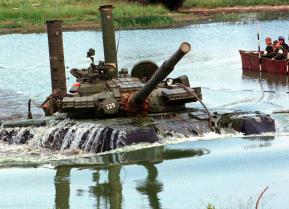Can a Russian T-90 Tank Survive an Attack from a U.S. TOW Missile?
We might have an answer.
The Shtora is an electro-optical jammer designed to disrupt guided missiles. It’s not clear if the jammers were switched on, or didn’t work, when the Hawks Mountain Brigade opened fire. Russian media has also reported that the particular tank was an earlier version of the T-90, so more recent upgrades, such as the T-90A which boasts a modified turret, should fare better.
For all the videos coming out of the Syrian civil war, a one minute, 31-second clip of a U.S.-made TOW missile slamming into a T-90 tank got more attention than most. In the video uploaded in February, Russia’s most advanced operational battle tank met one of the United States’ main tank killers on the battlefield.
(This first appeared several years ago.)
The T-90 was Russian made, but likely crewed by Syrian troops. The missile was supplied by the United States — most likely via Saudi Arabia or the CIA — to the Hawks Mountain Brigade fighting near Aleppo.
For the participants, the whole experience might have been terrifying. For most of the rest of the world, it was a chance to see what happens when state-of-the-art hardware from two major world powers violently collide in the Middle East.
The only good news is that nobody appeared to get killed. What happened to the tank … well, no one who watched the video was exactly sure.
We saw the wire-guided missile bob toward the T-90, which was parked on a crest between two low-slung buildings. Then the missile hit the tank’s turret with a tremendous flash which sent up a cloud of smoke. One of the crew members bailed and the video ended.
There was no fire and the tank didn’t “brew up,” meaning the fuel tank didn’t ignite and burn the crew to death. (The Syrian army has lost thousands of tanks since the war began in 2011.) This one, it seemed, survived.
A recent photograph circulated on Russian military forums shows what the tank looked like after impact. Sure enough, the T-90’s Kontakt-5 reactive armor appeared to save it. Reactive armor explodes outwards and stops incoming missiles from penetrating into the tank and killing the crew.
The Research Institute of Steel, a Russian company which makes reactive armor plates for the T-90, was pleased. The crew lived, according to Russian press reports, and the only visible damage was on one of the T-90’s two Shtora transmitters, which hanged limp in the photograph. However, the angle of the photograph only shows a glimpse of the side of the turret which was hit.
The Shtora is an electro-optical jammer designed to disrupt guided missiles. It’s not clear if the jammers were switched on, or didn’t work, when the Hawks Mountain Brigade opened fire. Russian media has also reported that the particular tank was an earlier version of the T-90, so more recent upgrades, such as the T-90A which boasts a modified turret, should fare better.
The photograph doesn’t tell us much more than add more evidence to what everyone already expected — that the missile disabled the tank, but didn’t destroy it. The T-90 was knocked out of the fight, and the Syrian army soon withdrew it to a repair plant, according to the Russian trade journal Military-Industrial Courier.
The main thing is that the armor appeared to accomplish its job. Losing a tank from the front line is one thing — it can always be replaced or repaired. The Syrian army was likely relieved to have saved the crew from being killed.
This piece first appeared in War Is Boring here.


